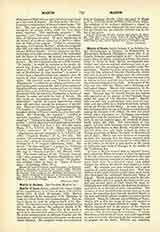

Martin IV (SIMON DE BRIE), POPE; b. at the castle of Montpensier in the old French province of Touraine at an unknown date; d. at Perugia March 28, 1285. As priest he held a benefice at Rouen for a short time, whereupon he became canon and treasurer at the church of St. Martin in Tours. King Louis IX made him Chancellor of France in 1260 and Urban VI created him cardinal-priest with the titular church of St. Cecilia in December, 1262. Under Urban VI (1261-4) and his successor, Clement IV (1265-8), he was legate in France with powers to offer the Kingdom of Sicily to Charles of Anjou on certain conditions. Under Gregory X (1271-76) he was sent as legate to France a ARMS OF MARTIN IV second time, with ample faculties to stem the abuses that had crept into the Church of France. In this capacity he presided over various reformatory synods, the most important of which was the one held at Bourges in September, 1276 (Mansi, Sacr. Conc. nova et ampl. Collectio XXIV, 165-180). Just six months after the death of Pope Nicholas III, Simon de Brie was unanimously elected pope at Viterbo on February 22, 1281. His election was due to Charles of Anjou who was present at Viterbo and caused the two most influential cardinals of the Italian faction to be imprisoned before the conclave, on the plea that they were retarding the election. Cardinal Simon de Brie accepted the tiara with reluctance and chose the name of Martin. Though he was only the second pope by the name of Martin he is generally known as Martin IV, because since the beginning of the thirteenth century the Popes Marinus I (882-4) and Marinus II (942-6) were listed among the Martins.
Unable to go to Rome where a pope of French nationality was hated, and unwilling to stay at Viterbo which was under interdict because it had imprisoned two cardinals, Martin IV went to Orvieto where he was crowned on March 23. Though personally pious and well-meaning, the new pope was dependent in everything on Charles of Anjou whom he at once appointed to the influential position of Roman Senator. He also assisted him in his endeavors to restore the Latin Empire of the East, and excommunicated the Greek emperor, Michael Palaeologus, of Constantinople, who opposed the plans of Charles of Anjou. By this imprudent act he broke the union which had been effected between the Greek and the Latin Churches at the Council of Lyons in 1274. After Sicily forcibly threw off the galling yoke of Charles of Anjou and gave expression to its deep hatred of France in the cruel massacre known as the Sicilian Vespers, Pope Martin IV used his full papal power to save Sicily for France. He excommunicated Peter III of Aragon whom the Sicilians had elected as their king, declared his kingdom of Aragon forfeited and ordered a crusade to be preached against him. But all his efforts proved useless. Among the seven cardinals created by Martin IV was Benedetto Gaetano, who afterwards ascended the papal throne as the famous Boniface VIII.
MICHAEL OTT

